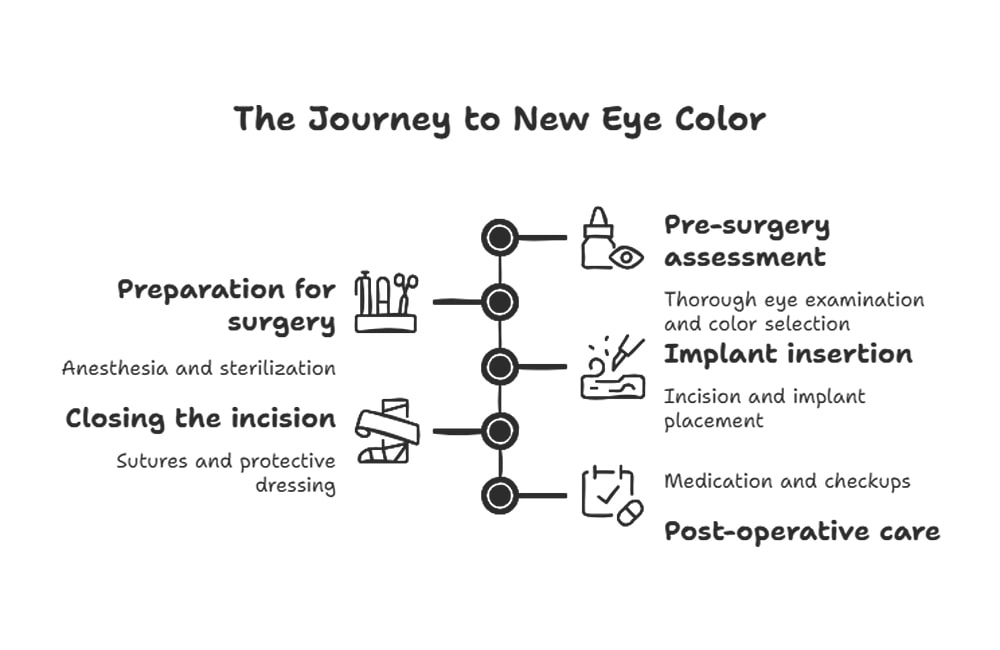Home / Eye Color Change via Implant Method


Eye Color Change via Implant Method: Everything You Need to Know
The eye color implant method is a surgical procedure that involves inserting a colored artificial iris into the eye to create a permanent change in eye color. While it was originally developed to address serious medical conditions such as missing or damaged irises, it has recently gained popularity as a cosmetic option for people seeking dramatic changes. However, this method carries significant risks and potential long-term damage to eye health, raising concerns about whether the pursuit of a new eye color is truly worth it. In this guide, we’ll explore how the procedure works, the serious complications that can arise, and why most experts advise caution when considering this risky approach to changing your eye color.
What is the eye color change implant method?
The eye color change implant method involves the insertion of a colored artificial iris implant into the eye. This permanent eye color change procedure is also known as iris implant surgery or colored lens implantation. It was initially developed to treat medical conditions such as damaged or missing irises, but today it is increasingly sought after for cosmetic purposes by those desiring a solution to change eye color.
History and development of iris implant technology
Iris implant technology was first introduced for therapeutic uses, especially for patients with aniridia, albinism, or traumatic injuries. However, in recent years, it has been irresponsibly marketed as a cosmetic eye surgery. Despite some misleading claims, many ophthalmologists warn against its cosmetic use due to the serious risks involved and the complete lack of long-term safety data for healthy eyes. Initially created for therapeutic use in conditions like aniridia, it’s now marketed for cosmetic purposes. However, safer alternatives like keratopigmentation exist.
How does the eye color implant procedure work?
The iris implant procedure is a complex surgical operation performed in several key stages:
- Assessment: Detailed eye exams determine eligibility, measure the eye, and confirm color choice.
- Preparation: The eye is sterilized under general anesthesia.
- Implantation: A small corneal incision allows placement of a colored implant in front of the natural iris.
- Closure: The incision is stitched and covered to prevent swelling or bleeding.
- Aftercare: Patients take medications, attend follow-ups, and recover vision over a few weeks.
Duration: The procedure lasts 1–2 hours.


Who is eligible for an eye color implant procedure?
This method is strictly recommended only for individuals with serious medical issues affecting the iris. Healthy individuals seeking cosmetic eye color change are at extremely high risk of severe complications and should avoid this procedure entirely. A thorough medical and eye health evaluation is essential before even considering this surgery.
How safe is the eye color implant method?
Despite being marketed as a cutting-edge cosmetic solution, the safety of eye color implants is still under review. Serious risks such as infection, glaucoma, cataracts, and even permanent vision loss have been reported. Therefore, it is not considered a safe procedure for individuals without a medical necessity.
Risks and complications of iris implant surgery
The complications of this method are numerous and extremely severe. They include:
- Infections
- Eye inflammation
- Increased intraocular pressure (glaucoma)
- Cataracts
- Blurry vision or complete vision loss
- Implant rejection
Moreover, the long-term effects remain uncertain, with possible unknown risks surfacing in the future.
Recovery process after eye color implant surgery
Recovery from iris implant surgery is lengthy and requires strict post-operative care:
- Use of prescribed eye drops
- Avoiding strenuous activities
- Regular follow-ups to monitor for dangerous complications
- Wearing UV-protective sunglasses
- Avoiding eye rubbing or trauma
- Maintaining high eye hygiene
Pros and cons of changing eye color via implant
Pros:
- Permanent eye color change
- Can also be used for medical treatment
- done in one surgery session
Cons:
- Extremely high risk of severe and irreversible complications
- Irreversibility or difficult removal process
- Expensive, especially in developed countries
- Some patients may experience disappointment if results don’t match expectations
- Not covered by insurance
Can the implant be removed or reversed?
In rare cases, implants may be removed, but the procedure is complicated and risky. Furthermore, the original eye color may not be fully restored, and permanent damage to vision is possible. and it’s important to know that for removing the implant they should do another surgery.
Difference between eye color implants and laser eye color change
Implants involve dangerous and invasive surgery, while laser eye color change uses non-invasive technology to reduce melanin in the iris. Laser methods are significantly safer than implants, although they may require multiple sessions and lead to high expenses.
Comparison of permanent vs. temporary eye color change methods
Temporary solutions like colored contact lenses are non-invasive, affordable, and easy to use but require daily maintenance. Implants, despite being permanent, are risky and outdated. Laser methods and keratopigmentation offer safer permanent alternatives.At Chromatic Eye Color Center, cutting-edge VisuMax laser technology is used to ensure precision and safety during the keratopigmentation procedure.
Aspect |
Permanent Methods (Keratopigmentation, Laser, Iris Implant*) |
Temporary Methods (Contact Lenses, Drops, Makeup) |
|---|---|---|
|
Duration |
Long-lasting / Lifetime |
Short-term / Daily use |
|
Safety |
Keratopigmentation: safe |
Lenses may cause infections |
|
Color Options |
Wide range (especially with keratopigmentation) |
Many options (lenses, makeup) |
|
Effectiveness |
Real and lasting color change |
Only visual or partial |
|
Availability at Chromatic |
Keratopigmentation (recommended) |
Lenses not recommended |


Ethical concerns surrounding eye color implants
Cosmetic iris implants raise serious concerns about unnecessary risks, the ethics of performing dangerous procedures, and the commercialization of surgeries that can lead to blindness. Many experts believe this procedure should be strictly limited to medical indications only.
Conclusion:
While eye color change with implants offers the allure of permanent transformation, it comes with significant risks, including loss of vision. Safer and more modern alternatives like keratopigmentation offer a minimally invasive solution with natural results and lower risk. Always consult with a specialized ophthalmologist to make an informed and safe decision about changing your eye color.
FAQs about eye color change via implant method
What happens if an eye color implant gets damaged?
A damaged implant can lead to severe eye trauma, infection, or permanent visual distortion. Immediate medical attention is required to avoid further complications or loss of vision.
What are the alternatives to eye color implant surgery?
The safest and most advanced alternative is keratopigmentation, a non-invasive method that changes eye color by injecting biocompatible pigments into the superficial cornea. It has fewer side effects and a faster recovery time.
Telephone consultation
We've got everything you need to make an informed decision about changing your eye color.
Consultation Services
During the consultation process, you can ask all your questions and explore various eye color change methods with our team of specialists. We provide all the essential information you need to make an informed decision about changing your eye color.



